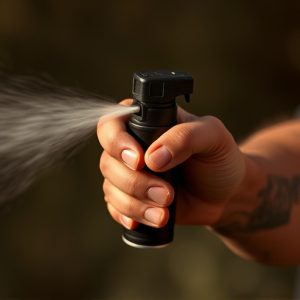Pepper Spray Storage in Car: Pros, Cons, and Legal Guide
Proper storage of pepper spray in cars is vital for maintaining its effectiveness and safety. This i…….
Proper storage of pepper spray in cars is vital for maintaining its effectiveness and safety. This includes cool, dry conditions away from direct sunlight and secure mounting to prevent shifting. It remains a crucial tool for civil unrest, but its use is subject to legal regulations and best practices, especially regarding child access and expiration dates.
“Discover the power and complexities of pepper spray, a tool often employed in riot control. This comprehensive guide explores its composition, effects, and role in public safety. We delve into the pros and cons of using pepper spray during civil disturbances, providing insights for law enforcement. Additionally, learn about responsible storage practices for pepper spray in your vehicle, ensuring it remains secure and accessible. Understand legal considerations and best practices to carry pepper spray legally, as we navigate this intricate topic related to Pepper Spray Storage in Car.”
- Understanding Pepper Spray: Composition and Effects
- The Role of Pepper Spray in Riot Control: Pros and Cons
- Safe Storage Practices for Pepper Spray in Your Vehicle
- Legal Considerations and Best Practices for Carrying Pepper Spray Legally
Understanding Pepper Spray: Composition and Effects
Pepper spray, a popular tool for riot control and self-defense, is a powerful chemical agent designed to cause temporary disorientation and pain in those exposed. Its primary active ingredient is capsaicin, a compound derived from chili peppers that stimulates nerve endings, leading to a burning sensation and reduced visibility. This non-lethal weapon comes in various forms, but its most common application is as an aerosol spray.
When stored appropriately, pepper spray can maintain its effectiveness for several years. Pepper spray storage in car requires special consideration due to the potential heat fluctuations and exposure to light. It’s recommended to keep it in a cool, dry place, away from direct sunlight, and to store it in a dedicated container designed to protect against these environmental factors. Proper storage is crucial to ensure its readiness when needed, providing individuals with an essential tool for personal safety during unpredictable situations.
The Role of Pepper Spray in Riot Control: Pros and Cons
Pepper spray has long been a staple tool for riot control and crowd management due to its effectiveness in disorienting and neutralizing individuals quickly. It works by irritating the eyes, nose, and respiratory system, leading to temporary blindness, coughing, and difficulty breathing, allowing law enforcement or security personnel to regain control of chaotic situations. The use of pepper spray is widely regarded as a less lethal alternative to other force options, making it a preferred choice in many jurisdictions for de-escalating tense scenarios without causing permanent harm.
Despite its advantages, there are also drawbacks and controversies surrounding the use of pepper spray. Concerns include potential misuse or abuse by officers, accidental discharge during storage or transport, and health risks for individuals with pre-existing respiratory conditions or sensitivities. Proper training, strict protocols, and secure pepper spray storage in cars or other tactical equipment are essential to mitigate these issues. The debate over its effectiveness and ethical use continues, especially as newer non-lethal agents enter the market, but pepper spray remains a critical tool in the arsenal for maintaining public safety during riots and civil unrest.
Safe Storage Practices for Pepper Spray in Your Vehicle
When storing pepper spray in your vehicle, it’s crucial to prioritize safety and accessibility. Keep the spray out of reach of children and unsecured areas, such as glove compartments or under seats, where it could shift during movement. Instead, install a dedicated storage solution like a secure mount or case that fixes firmly to the dashboard or a door panel. This ensures the spray remains stable and readily available in an emergency.
Proper ventilation is another key aspect of safe pepper spray storage. Avoid placing it in enclosed spaces with limited air circulation to prevent the buildup of any potential noxious fumes. Ensure your vehicle’s interior ventilation system functions optimally, and consider parking in well-ventilated areas when not in use. Regularly check the expiration date of the spray and replace it promptly if needed, as its effectiveness diminishes over time.
Legal Considerations and Best Practices for Carrying Pepper Spray Legally
When it comes to carrying pepper spray for riot control, legal considerations are paramount. Different jurisdictions have varying laws and regulations regarding the possession, use, and storage of pepper spray, or oleoresin capsicum (OC) spray. In many places, it’s only legal for specific individuals, such as law enforcement officers, security personnel, or those with a valid concealed carry permit, to own and carry pepper spray. It’s crucial to understand local legislation before purchasing and using this tool to ensure compliance and avoid legal repercussions.
Best practices for carrying pepper spray legally include proper storage in a secure location, typically within the vehicle. Pepper spray should be stored out of reach of children and unauthorized individuals. It’s recommended to keep it in its original packaging with clear labeling, indicating its contents and any safety instructions. Additionally, regular maintenance is essential; check expiration dates, ensure the nozzle is intact, and store it away from extreme temperatures or direct sunlight. Adhering to these guidelines not only helps in legal defense but also ensures the spray remains effective when needed most.
Pepper spray, while a valuable tool in riot control, requires careful handling and responsible storage. When used appropriately, it can effectively de-escalate tense situations and maintain public safety. However, improper use or inadequate storage may lead to legal consequences. For those choosing to carry pepper spray in their vehicles, adhering to safe storage practices and understanding local regulations regarding Pepper Spray Storage in Car is paramount to ensure both personal safety and legal compliance. By following these guidelines, individuals can effectively utilize this tool while mitigating potential risks.


